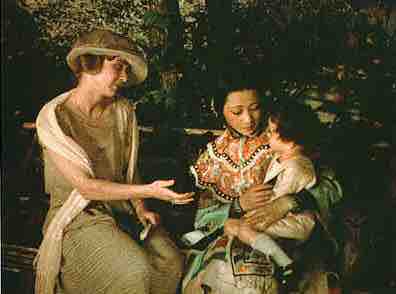At the beginning of the 1920s, films were silent and colorless. By the end of the decade, cinema had changed significantly with major leaps in technology that marked the Golden Age of Hollywood and ended the era of the silent film, which itself had ended the previous, widespread popularity of Vaudeville Theater. Box office sales leapt to new heights as the studio system became the dominant business model in movie making.
Color and Talkies
The first all-color feature, "The Toll of the Sea," was released in 1922, with the next big leap coming in 1926 with the Warner Brothers Pictures (later shortened to Warner Bros.) release of "Don Juan," the first feature with sound effects and music. In 1927, Warner Bros. followed that cinematic milestone with another in the form of "The Jazz Singer," the first sound feature to include limited talking sequences. This release arguably launched the Golden Age of Hollywood.
The Jazz Singer, 1927
Theatrical poster for "The Jazz Singer", the first feature film to include talking sequences, which began the era of the "Talkies."
The public went wild for Talkies and movie studios converted to sound almost overnight. In 1928, Warner Bros. released "Lights of New York," the first all-talking feature film. In the same year, the first sound cartoon, "Dinner Time," was released. Warner Bros. ended the decade in 1929 by unveiling the first all-color, all-talking feature film, "On with the Show."
Animation
Cartoon shorts, using the moving sketch technique of animation, were popular in movie theaters during this time. The late 1920s saw the emergence of Walt Disney and his eponymous studio. Disney’s marquee character, Mickey Mouse, made his debut in "Steamboat Willie" on November 18, 1928, at the Colony Theater in New York City. Mickey would go on to star in more than 120 cartoon shorts, as well as "The Mickey Mouse Club" and other specials. This jump-started Walt Disney Studios and led to the creation of other characters going into the 1930s. Oswald, a character created by Disney in 1927 before Mickey, was contracted by Universal Studios for distribution purposes and starred in a series of shorts between 1927 and 1928. He was the first Disney character to be merchandised.
Walt Disney
In 1928 Walt Disney gave the world "Steamboat Willie," aka Mickey Mouse, followed by numerous other cartoon characters who have become instantly recognizable.
The Studios and Stars
Most Hollywood pictures adhered closely to a formula – Western, slapstick comedy, musical, animated cartoon, or biopic – and the same creative teams often worked on films made by the same studio. Cedric Gibbons and Herbert Stothart always worked on MGM films, Alfred Newman worked at 20th Century Fox for 20 years, Cecil B. De Mille's films were almost all made at Paramount Pictures, and director Henry King's films were mostly made for 20th Century Fox.
Each studio had its own style and characteristic touches. Films were also easily recognizable as the product of a specific studio largely based on the actors who appeared. MGM, for example, claimed it had contracted "more stars than there are in heaven."
The period saw the emergence of box office stars, many of whom are still household names, such as Mae Murray, Ramón Novarro, Rudolph Valentino, Charlie Chaplin, Buster Keaton, Harold Lloyd, Warner Baxter, Clara Bow, Louise Brooks, Bebe Daniels, Billie Dove, Dorothy Mackaill, Mary Astor, Nancy Carroll, Janet Gaynor, Charles Farrell, William Haines, Conrad Nagel, John Gilbert, Greta Garbo, Dolores del Río, Norma Talmadge, Colleen Moore, Nita Naldi, John Barrymore, Norma Shearer, Joan Crawford, Mary Pickford, Douglas Fairbanks, Anna May Wong, and Al Jolson.
Louise Brooks
American actress Louise Brooks was one of the box office stars who became famous in the 1920s at the outset of the Golden Age of Hollywood.
Each of these stars was contracted to work for a specific studio and distribution company, which was one aspect of the studio system that became the dominant Hollywood business model and continues today, albeit in a far less restrictive form that does not tie actors to any specific company.
Theater Monopolies
After the release and huge success of "The Jazz Singer" in 1927, Warner Bros. was able to acquire its own string of movie theaters, purchasing Stanley Theaters and First National Productions in 1928. MGM had owned the Loews string of theaters since its formation in 1924, while the Fox Film Corporation owned the Fox Theatre chain. Paramount, which had already acquired Balaban and Katz in 1926, purchased a number of theaters in the late 1920s, to the point of holding a monopoly on theaters in Detroit, Michigan. By the 1930s, all of America's theaters were owned by the Big Five studios: MGM, Paramount Pictures, RKO, Warner Bros., and 2oth Century Fox.

The Toll of the Sea, 1922
“The Toll of the Sea,” released in 1922, was the first color feature made in Hollywood.